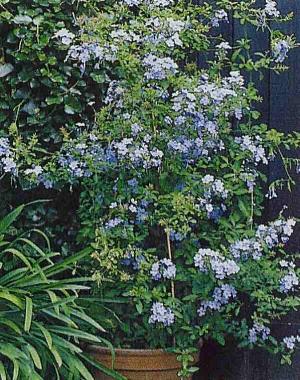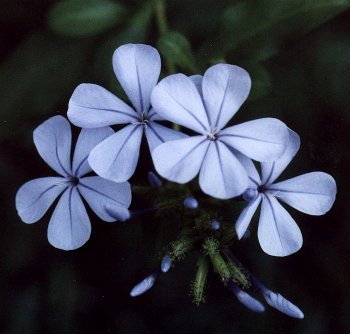|
Plants for your home
(By Mary Efanti)
Plumbago
 Origin - Description Origin - Description
Plumbago
(Leadwort) or blue jasmine as many of us, including nursery employees, call this
plant. Those of us who live in big cities, and especially in Athens, see it everyday on sidewalks or green spots created just recently by the Municipality of
Athens.
Plumbago was not randomly selected for this use, as it is a shrub that grows very
easily, with no particular care needs, with rich foliage and long lasting
flowers. It originally came from South Africa but became quite popular in all countries with moderate
climate. In the past few years new varieties have been introduced, with white, pink and dark blue
flowers.
Care
Plumbago can be cultivated as easily in pots and
gardens. It can also be used for rock gardens but its most suitable use is for borders if pruned
low, on fences or pergolas and trellises in order to create a flowery screen. It grows very quickly and under suitable conditions its height can outgrow two
meters.
If you want to create a
screen, try to tie the basic branches horizontally, removing weak branches from the main
trunk. The shape of the plant should remind you of the steps of a ladder. This shaping will provide full coverage of the trellis as the plant
grows.
Plumbago is a sun loving plant. Direct sunlight for many hours daily is
necessary, even on the hottest summer days. The number of flowers produced depends mainly on how much sun the plant
gets, in other words more sunlight, more flowers.
Blooming starts in early spring and lasts until late fall or until temperature drops below 15´C. Its flowers consist of 5
petals, in a sweet pale blue color. They appear in groups at the top of each
branch, have no fragrance and stick to clothes. Plumbago's blooming is very
rich, under good conditions, so rich that flowers get to be more than the leaves. You will definitely appreciate a pale blue flowery trellis on your balcony or
garden. So will butterflies who are attracted by the flowers of this plant.
Water often because plumbago also loves
water, on those very hot summer days you may have to water every day with plenty of
water. Plumbago will wilt immediately if it needs watering so you will know when to
water. A few hours after watering the plant will get back to normal but don't let the soil dry out completely because the plant will
die. If it survives, its development will be greatly compromised. During
winter, when the plant has no leaves or flowers you will need to water once a week or less often depending on the
weather.
In the
garden, plumbago is not demanding in terms of soil quality. If however your soil is heavy
clay, dig and add some packaged all-purpose soil to the garden every now and
then. If in pot, any packaged soil will do, make sure though to add some mulch and provide excellent
drainage. In either pot or garden choose a sunny spot, protected from cold and harsh
winds.
Plumbago is a deciduous plant, when the weather cools down it will start to drop leaves ending up to a mess of naked branches that look dead. This is the best time to prune as you can now see the branches and can form the desired shape and size. Prune back as hard as you wish and don't worry because its rapid growth in spring will camouflage any mistakes. A light pruning during blooming will help remove dead flowers and leaves while at the same time by pinching top growth you will get a bushier
plant.
 During winter use a plastic cover to protect the plant from freezing as it does not stand
cold. If freezing occurs before you get the chance to cover the plant, and does not last
long, your plant will most probably survive since only the above-soil-part of the plant is damaged and not the root
system. In this case, do not prune until new growth develops so that you will be able to distinguish which parts of the plant are dead and cut them
off. During winter use a plastic cover to protect the plant from freezing as it does not stand
cold. If freezing occurs before you get the chance to cover the plant, and does not last
long, your plant will most probably survive since only the above-soil-part of the plant is damaged and not the root
system. In this case, do not prune until new growth develops so that you will be able to distinguish which parts of the plant are dead and cut them
off.
Propagation is usually done in spring by division of the
roots. You can also try transplanting side shoots. In this case, dig around the base of the plant trying to remove the side shoot with as many roots as
possible. Transplant it in a small pot until it grows and then go ahead and plant it in any larger
pot.
Repotting should be done in spring or early
fall. Repot when the roots have occupied all the space because plumbagos like to be a little pot
bounded. Depending on the size of the plant you should repot every 2-3 years.
Use liquid
fertilizer, for blooming plants, every 15 days from spring till fall. Also, during this blooming
period, add some liquid iron every 2 months to enhance the green color of the leaves that tend to yellow
easily.
Plumbago is extremely resistant to disease and
insects. However, if other neighboring plants are affected, check your plant often to make sure it is not affected as
well.
Pale blue like the sky, not demanding at all, hardy and the perfect screen to keep curious eyes
away. One of the plants you should buy, suitable for all, experienced and novice
gardeners.
Mary Efanti
mefanti@otenet.gr
|
